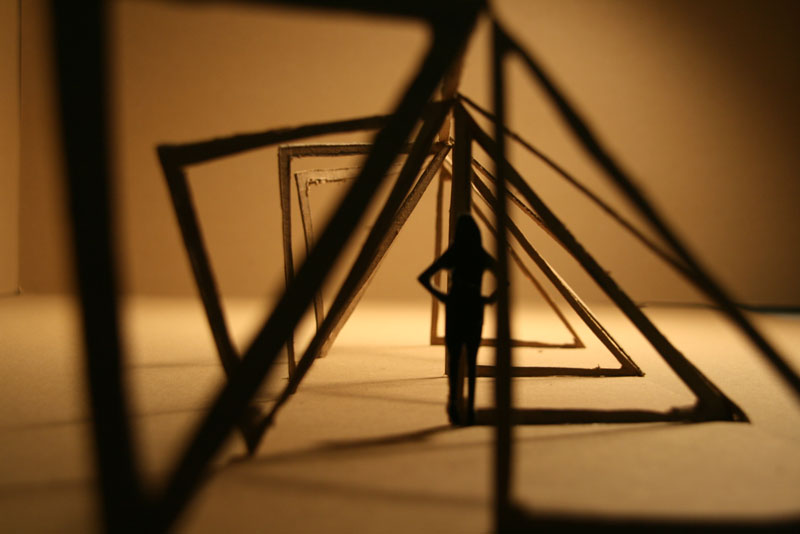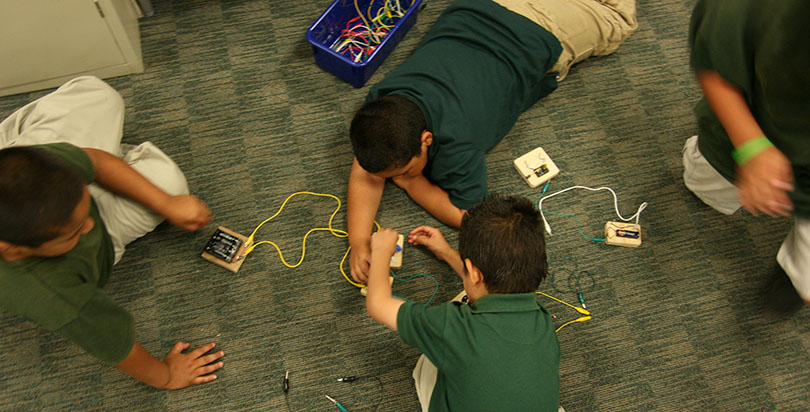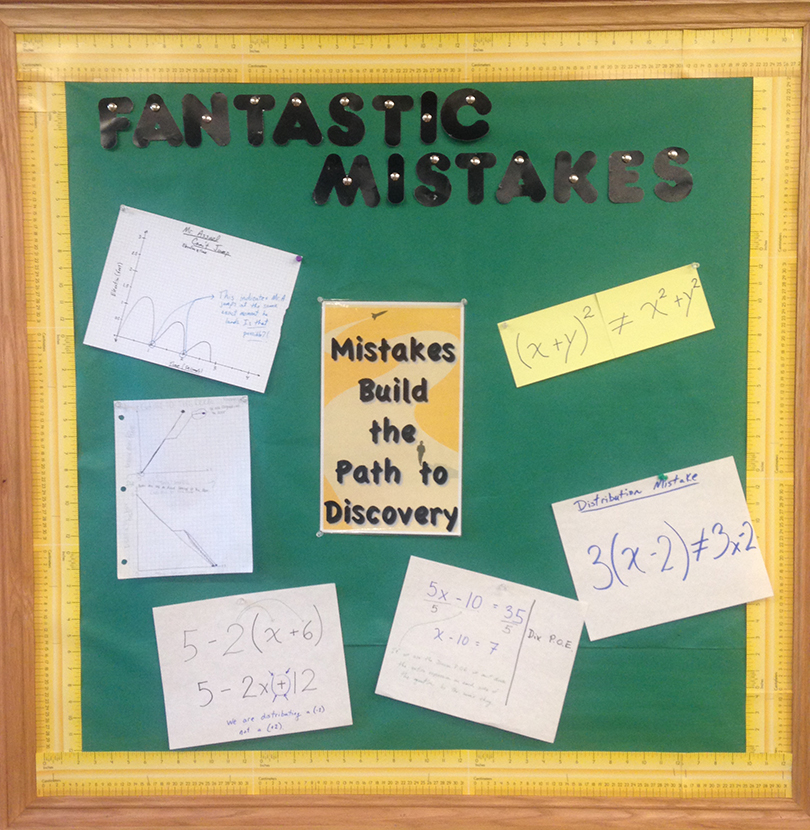Finding Success in Failure: STEM Educators Say Student Risk-Taking Is Key to Real-World Learning

Some students grab paper and begin sketching. Others shift in their seats and look bewildered. The directions aren’t much to go on. What exactly is Mr. Simon looking for?
The uncertainty is intentional. Rather than giving his students specific, detailed directions, Simon wants them to learn through discovery. After all, that’s how real designers approach a project: not with answers, but questions.
“They’re taking a risk because they don’t understand what the intended outcomes are,” Simon said. “They need to be analytical as they’re manipulating shapes and spaces so they can see when they stumble into something interesting.”
Soon, this begins to happen. A student sits and thinks, then starts drawing. She crumples up her paper and consults some design books, then sits back down and draws a triangle. Then she draws two more. She cuts them out and moves them around her desk, analyzing.
Simon approaches. He points out a fourth triangle frame that her three solid triangles have formed. Is there a way to create a building design with this theme?
And she does. So, eventually, does the rest of the class: Three weeks later, the students have wrestled their chipboard into unique building models, after many rounds of trial and error.

Simon’s approach to teaching architecture —a system of experimentation, risk and uncertainty — mirrors the recommendations of a STEM report released by the U.S. Department of Education and the American Institutes for Research in September. The report suggested that exposure to risk and failure in the classroom is essential for math, science, engineering and technology education, because it reflects real-world STEM career practices.
Teaching this way poses challenges for both educators and students. For teachers, it means devoting much more time to letting students figure out solutions for themselves — in a school day that is already very tightly scheduled. For students, it means taking greater responsibility for mastering difficult subject matter — and it raises the very real prospect of getting bad grades if they can’t puzzle through challenging questions.
Still, most educators agree that, in the long run, learning through mistakes gives students a better understanding of the skills needed for STEM success — training that most schools currently do not provide.
“STEM education in formal school settings does not consistently promote some of the core values and practices of science and engineering in practice; namely, searching for uncertainty, recognizing ambiguity, and learning from failure,” the report says. The words “fail” and “risk” appear in the report 32 times.
As if to prove the point, the report came out just before the release of the 2015 National Assessment of Educational Progress science scores, which showed 60 percent of all students performing at “basic” or “below basic” levels. Though scores rose slightly for fourth- and eighth-graders versus the 2009 exams, results were stagnant among high school students.
(The 74: Science Scores on ‘Nation’s Report Card’ Rise in Fourth and Eighth Grade, Stay Stagnant in 12th)
This trend, and what to do about it, has spurred lengthy discussions within the science-education community. In mid-October, Scientific American and Macmillan Learning hosted STEM Summit 4.0, where STEM educators and leaders gathered in New York to talk about the power of data. But just as often, the conversation turned to the power of failure.
Among the speakers was Russ Shilling, executive director of STEM Initiatives at the U.S. Department of Education, who said these subjects beg for a learning model that exposes students to risk and failure. But giving teachers time for experimentation in class can be challenging, he said, considering the amount of content they need to cover to prepare students for standardized tests.
“We’re hoping the new ESSA [the federal Every Student Succeeds Act] will actually start taking some of the pressure off and let us innovate more in the schools,” Shilling said.
Melissa Moritz, U.S. Education Department deputy director of STEM initiatives, told The 74 the flexibility in testing and accountability that ESSA provides could give teachers greater opportunity to create space for risk-taking. “The educators I talked with, they love teaching in this way,” she said.
Providing more teacher support is important amid a shortage of STEM educators, said conference speaker Talia Milgrom-Elcott, executive director and co-founder of 100Kin10, an organization that supports STEM teacher training.
(The 74: Answering the Call: How 100Kin10 Is Working to Add STEM Teachers to America’s Classrooms)
How to allow for this in the classroom is a tough question, so tough that 100Kin10 instituted a fellowship to gather thought leaders on how to make this happen. But a starting point is creating teacher evaluations that encourage experimentation and creativity, Milgrom-Elcott said. Teachers also should be made to feel comfortable telling students when they themselves don’t know the answers, which encourages a pattern of learning throughout adulthood.
“It’s OK to learn and fail in the classroom,” she said at the conference. “If we want our kids to be actual scientists and willing to experiment, our teachers need to be willing to do it too.”
When Washington, D.C., math teacher Dan Assael began teaching a support math class for struggling students at Alice Deal Middle School a few years ago, he knew it would be a challenge. His students had to give up fun electives like phys ed and art to spend an extra hour learning math, a subject in which some of them had first-grade proficiency. Their anxiety toward math was high, their self-confidence low, their interest in being there even lower.
So Assael did some research and found advice — from author and Uncommon Schools Managing Director Doug Lemov, for example — on creating a “culture of error.” He latched onto the idea that when students feel comfortable making mistakes in front of their teacher and peers, they are less likely to shut down and more likely to learn from their misunderstandings.
“Math anxiety, and the idea that the only way to be successful is to have the right answer, were really holding up student learning,” Assael said. He wanted to create an environment where “thoughts were valued, and not just their answers.”
This required adjusting how he responded to students, eliminating any judgmental tone toward right or wrong answers. He had his students work in groups, rather than tackling math problems individually, and share their thought processes with their partners. Right or wrong, they had to explain how they got their answers. When he asked students questions and they said “I don’t know,” Assael responded, “I don’t need to know what you know; I need to know what you think.”
His experiment worked. Based on his own data, 15 students improved their math proficiency by one to two grade levels during his semester-long course.
Assael laughed when asked whether this kind of learning takes extra time. “Absolutely,” he said. Even though procedural and deep conceptual learning is part of the Common Core, he said, it can be difficult to cover all the content by the time the state standardized PARCC tests roll around. But that’s just part of the deal.
“I’d rather them get skills to be great learners than skills to be great Algebra I students,” he said.
At Basis Independent Brooklyn, a P-12 private-school STEM powerhouse in New York, middle school chemistry teacher Na Xue is careful not to seem to be looking for one correct answer to experiments. She said other teachers at BASIS also encourage their students to take risks and make mistakes.
“The moment you shut them down and say, ‘This is wrong or right,’ they get discouraged,” she said.
But when students have permission to fail, Xue said, they learn perseverance. She recalled one group of students in a lab who were conducting an experiment to see how sugar affected the color of gases. As the students set up their experiment, they found they couldn’t even produce gas, much less evaluate its color. After multiple failures, they finally figured out that the crayon dye they were using to produce colored gases was stifling the process, and that using food coloring instead solved the problem. This completely changed their experimental question and opened up a new lesson on redox, or oxidation-reduction, reactions — something the students hadn’t learned in class.
“This is how startups happen as well: trial and error,” Xue said. “This is where greatness comes from.”
The elementary school teachers at Lighthouse Community Charter School liked the idea of exploratory learning. But how were they supposed to find enough time to cover all the material needed for standardized tests?
That was the challenge for Lighthouse Creativity Director Aaron Vanderwerff. So he sat down with teachers to look at their lesson plans and find ways to make adjustments — in some cases, turning a standard approach to teaching on its head. For example, rather than giving the class a vocabulary list before starting a lesson on batteries, teachers would roll out phrases such as “parallel circuits” as students discovered how to connect circuits using wires and LED lights. Instead of filling out a worksheet at the beginning of a lesson about rockets, students first built the rockets, explored what happened if they added extra fins or nose cones, and then wrote their discoveries on strips of paper to display on the wall.

Younger students quickly adjusted to this new kind of learning, but the older ones, accustomed to traditional instruction, initially became frustrated. “Why aren’t you teaching me?” Vanderwerff said the students asked, as teachers encouraged them to explore and learn for themselves. Though he said frustration was valuable to a point, teachers had to make sure it didn’t inhibit learning.
“I think for a lot of kids, when they get a bad grade, that can really hit home and doesn’t necessarily evoke a mindset of ‘What do I do to fix this? What can I learn from this?’ ” Vanderwerff said.
One solution is a degree of leniency in the grade book. Simon, the architecture teacher at High Tech High, allows for partial credit when students correct homework, which he said gives an incentive to learn from mistakes. When Xue grades chemistry labs, she doesn’t count an entire lab as incorrect if the initial data collection was wrong, because she needs her students to learn the scientific process as well as draw the right conclusions.
For Assael, the Washington math teacher, getting kids to make up for missed learning rather than just missed points meant changing the way he gives tests. Rather than using multiple-choice questions, he provides problems that require students to show all their work. Grading is a two-day process — the first day, students get test papers back with comments questioning their thinking, which gives them a chance to respond and re-evaluate their answers before resubmitting tests for a final score. Assael also allows the final test score to replace earlier grades on quizzes that students might have scored poorly on as they were learning.
Still, it’s a fine line to walk, because students also need to leave a unit having learned correct information.
“Teachers associate mistakes with failure, and I think that’s extreme,” Xue said. “I don’t like to grade too harshly with students when they make mistakes. But I don’t say everything is correct because then they don’t know what to learn from.”
Assael now teaches eighth-graders Algebra I, but he maintains the culture of error he started in his math support group class. A daily reminder of this is a bulletin board covered in green paper and topped with big black letters that read “Fantastic Mistakes.” Pinned to it are common errors Assael sees students make.
The students eagerly own this mistake-friendly culture. Assael reports more engagement. As he walks by group discussions, he hears students asking each other to prove rather than give their answers. Recently, a student approached him with an assignment that had an error and asked if she could put it on the “Fantastic Mistakes” board.
Assael also has a bulletin board in his class for exemplary work. But it’s a testimony to the learning culture he created that while the “exemplary” board has five pieces of student work, the “Fantastic Mistakes” board has six.

Get stories like these delivered straight to your inbox. Sign up for The 74 Newsletter

;)
